The global AI in packaging design market is forecasted to grow from USD 3.2 billion in 2025 to approximately USD 10 billion by 2035, recording an absolute increase of USD 6.8 billion over the forecast period. This translates into a total growth of 215.6%, with the market forecast to expand at a CAGR of 12.2% between 2025 and 2035. The market size is expected to grow by nearly 3.2X during the same period, supported by increasing adoption of artificial intelligence in design automation, rising demand for personalized packaging solutions, and growing focus on renewable packaging development through AI-driven optimization.
Between 2025 and 2030, the AI in packaging design market is projected to expand from USD 3.2 billion to USD 5.7 billion, resulting in a value increase of USD 2.5 billion, which represents 36.8% of the total forecast growth for the decade. This phase of growth will be shaped by rising implementation of machine learning algorithms in design processes, increasing demand for rapid prototyping capabilities, and growing integration of AI tools in packaging workflow automation. Technology companies and packaging manufacturers are expanding their AI-powered design capabilities to address the growing demand for efficient and innovative packaging solutions.
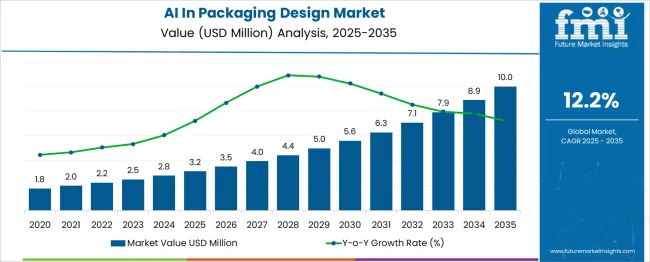
| Metric | Value |
| Estimated Value in (2025E) | USD 3.2 billion |
| Forecast Value in (2035F) | USD 10.0 billion |
| Forecast CAGR (2025 to 2035) | 12.2% |
From 2030 to 2035, the market is forecast to grow from USD 5.7 billion to USD 10.0 billion, adding another USD 4.3 billion, which constitutes 63.2% of the ten-year expansion. This period is expected to be characterized by widespread adoption of generative AI technologies, integration of predictive analytics in packaging development, and advancement of computer vision systems for quality control. The growing focus on circular economy principles and regulatory compliance will drive demand for AI solutions that optimize packaging design for recyclability.
Between 2020 and 2025, the AI in packaging design market experienced substantial expansion, driven by digital transformation initiatives across the packaging industry and accelerated adoption of automation technologies. The market developed as packaging companies recognized the need for intelligent design tools to reduce time-to-market, minimize material waste, and create more engaging consumer experiences. Industry 4.0 initiatives and smart manufacturing trends began emphasizing the importance of AI integration in packaging design workflows for maintaining a competitive advantage.
Market expansion is being supported by the increasing need for faster design iterations and reduced product development cycles in the highly competitive packaging industry. Modern packaging companies are leveraging AI technologies to automate repetitive design tasks, generate multiple design variations, and optimize packaging structures for performance and cost-effectiveness. The technology's ability to analyze consumer preferences, predict market trends, and create personalized packaging solutions makes it an essential tool for brands seeking differentiation in crowded markets.
The growing focus on green practices and regulatory compliance is driving demand for AI solutions that can optimize material usage, reduce environmental impact, and ensure adherence to packaging regulations across different markets. Consumer demand for innovative and interactive packaging experiences is creating opportunities for AI-powered design tools that can create augmented reality features, smart packaging elements, and dynamic design adaptations. The rising influence of e-commerce and omnichannel retail is also contributing to increased adoption of AI technologies that can optimize packaging for multiple distribution channels and customer touchpoints.
The market is segmented by technology outlook, industry vertical outlook, end use outlook, and region. By technology outlook, the market is divided into generative design AI, computer vision, natural language processing, and AI-powered simulation and testing. Based on industry vertical outlook, the market is categorized into food and beverage, healthcare and pharmaceuticals, consumer electronics, and personal care and beauty. In terms of end use outlook, the market is segmented into manufacturers and packaging companies, e-commerce and retail, and packaging design agencies. Regionally, the market is divided into North America, Europe, East Asia, South Asia & Pacific, Latin America, and the Middle East & Africa.
The generative design AI technology is projected to account for 37.2% of the AI in packaging design market in 2025, establishing its position as the most transformative technology in the sector. This technology enables designers to input specific parameters such as materials, manufacturing methods, cost constraints, and performance requirements, allowing AI algorithms to generate thousands of design alternatives that meet these criteria. The ability to explore design possibilities beyond human imagination while optimizing for multiple objectives simultaneously makes generative design AI particularly valuable for complex packaging challenges.
This technology is revolutionizing the traditional design process by dramatically reducing the time from concept to prototype while ensuring optimal use of materials and manufacturing resources. Major packaging companies are increasingly adopting generative design AI to create innovative structural designs that balance aesthetic appeal with functional requirements such as product protection, stackability, and shipping efficiency. The technology's capacity to incorporate green performance metrics into the design process, automatically optimizing for recyclability and material reduction, aligns perfectly with industry priorities and regulatory requirements, ensuring its continued dominance in the AI packaging design landscape.
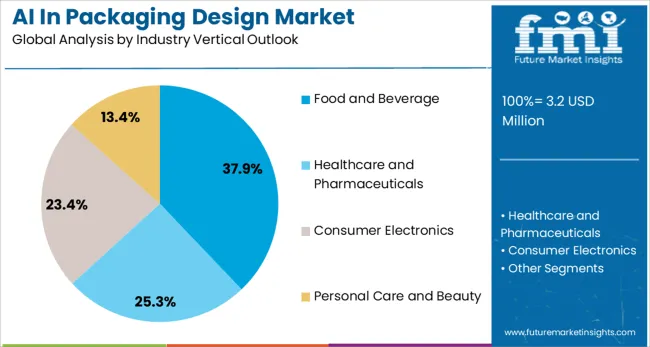
Food and beverage is projected to represent 37.9% of AI in packaging design demand in 2025, reflecting the industry's position as the largest consumer of packaging materials globally. This sector faces unique challenges, including stringent food safety regulations, varying shelf-life requirements, and the need for packaging that maintains product freshness while appealing to consumers. AI technologies are being deployed to address these complex requirements by optimizing barrier properties, predicting package performance under different storage conditions, and creating designs that enhance brand visibility on crowded retail shelves.
The segment benefits from AI's ability to analyze vast amounts of consumer data to identify packaging preferences, optimize portion sizes, and create region-specific design variations that resonate with local markets. The food and beverage industry's focus on eco-friendliness is driving the adoption of AI tools that can redesign packaging systems to reduce plastic usage, improve recyclability, and minimize food waste through better preservation capabilities. As regulatory pressures intensify and consumer expectations evolve, AI-powered design solutions will continue to be essential for food and beverage companies seeking to balance functionality and market appeal.

The packaging design agencies segment is forecasted to contribute 40% of the AI in packaging design market in 2025, highlighting their role as early adopters and innovation drivers in the industry. These specialized agencies are leveraging AI technologies to enhance their creative capabilities, streamline design workflows, and deliver more value to clients through data-driven design decisions. By integrating AI tools into their processes, agencies can produce more design concepts in less time, test virtual prototypes before physical production, and provide clients with predictive insights about market reception.
Design agencies are particularly well-positioned to maximize AI benefits as they work across multiple industries and brands, allowing them to build comprehensive datasets that improve AI model performance over time. The segment also benefits from agencies' ability to combine human creativity with AI capabilities, using technology to handle repetitive tasks while designers focus on strategic and creative elements. With brands increasingly demanding faster turnaround times, more personalized solutions, and evidence-based design decisions, packaging design agencies equipped with AI capabilities will continue to capture significant market share and drive industry innovation forward.
The AI in packaging design market is advancing rapidly due to increasing digitalization of design processes and growing demand for renewable packaging solutions. The market faces challenges including high initial investment costs, integration complexity with existing systems, and concerns about intellectual property protection in AI-generated designs. Innovation in machine learning algorithms and cloud-based design platforms continues to influence adoption patterns and market expansion strategies.
The growing adoption of cloud-based AI platforms is enabling real-time collaboration between designers, manufacturers, and brands regardless of geographical location. These platforms offer scalable computing power for complex AI operations, automatic updates with latest algorithms, and seamless integration with existing design software ecosystems. The shift towards cloud infrastructure is democratizing access to advanced AI capabilities, allowing smaller packaging companies and design studios to compete with larger enterprises.
Modern AI systems are incorporating sophisticated computer vision capabilities to automatically detect design flaws, predict manufacturing issues, and ensure brand consistency across packaging variations. These technologies can analyze thousands of package designs per minute, identifying potential problems that human inspectors might miss. Advanced vision systems also enable real-time feedback during the design process, suggesting improvements based on manufacturability, shelf appeal, and regulatory compliance requirements.
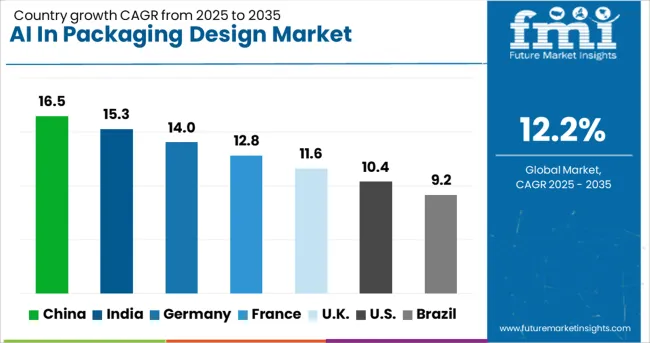
| Country | CAGR (2025-2035) |
| China | 16.5% |
| India | 15.3% |
| Germany | 14% |
| France | 12.8% |
| UK | 11.6% |
| USA | 10.4% |
| Brazil | 9.2% |
The AI in packaging design market is experiencing robust growth globally, with China leading at a 16.5% CAGR through 2035, driven by massive manufacturing scale, government support for AI development, and rapid digital transformation across industries. India follows at 15.3%, supported by growing IT capabilities, expanding consumer goods sector, and increasing focus on packaging innovation. Germany shows strong growth at 14.0%, emphasizing engineering excellence and renewable design practices. France records 12.8%, focusing on luxury packaging and design innovation. The UK demonstrates 11.6% growth, prioritizing creative design and digital technology integration. The report covers an in-depth analysis of 40+ countries; top-performing countries are highlighted below.
Revenue from AI in packaging design in China is projected to exhibit strong growth with a CAGR of 16.5% through 2035, driven by the country's position as the world's largest manufacturing hub and aggressive AI development initiatives. China's massive e-commerce market and growing consumer goods sector are creating unprecedented demand for innovative packaging solutions that can be rapidly designed and produced at scale. Government support through Made in China 2025 and AI development plans is accelerating adoption of intelligent design technologies across the packaging value chain.
Revenue from AI in packaging design in India is expanding at a CAGR of 15.3%, supported by rapid digitalization, the growing FMCG sector, and increasing focus on packaging quality and innovation. The country's strong IT services sector provides technical expertise for AI implementation, while rising consumer expectations drive demand for sophisticated packaging solutions. Both multinational corporations and domestic companies are investing in AI-powered design tools to enhance competitiveness and reduce time-to-market.
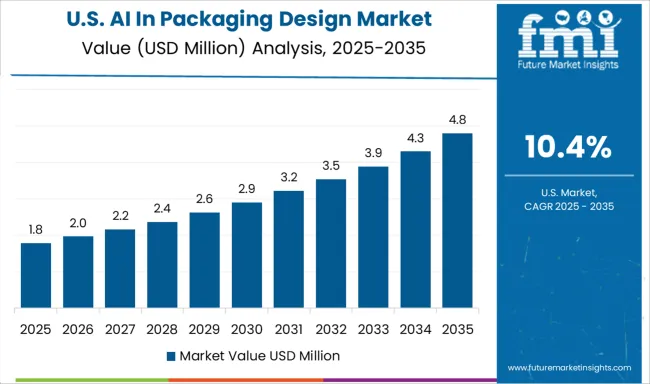
Demand for AI in packaging design in the USA is projected to grow at a CAGR of 10.4%, supported by strong technology infrastructure, a mature design industry, and focus on renewable packaging solutions. American companies are leading development of advanced AI algorithms for packaging optimization, with significant investment in research and development. The market benefits from strong collaboration between technology providers, packaging companies, and academic institutions.

Revenue from AI in packaging design in Germany is projected to grow at a CAGR of 14.0% through 2035, driven by the country's strong manufacturing base, engineering expertise, and commitment to renewable packaging innovation. German companies are integrating AI technologies with precision engineering to create optimized packaging solutions that meet stringent quality and environmental standards.
Revenue from AI in packaging design in France is projected to grow at a CAGR of 12.8% through 2035, supported by the strong luxury goods sector and focus on premium packaging aesthetics. French companies are leveraging AI to create sophisticated designs that combine artistic excellence with functional optimization and environmental requirements.
Revenue from AI in packaging design in the UK is projected to grow at a CAGR of 11.6% through 2035, supported by the country's vibrant design industry and strong digital technology sector. British companies are combining creative expertise with AI capabilities to deliver innovative packaging solutions that meet evolving consumer and regulatory requirements.
Revenue from AI in packaging design in Brazil is projected to grow at a CAGR of 9.2% through 2035, supported by the country's large consumer market and growing packaging industry. Brazilian companies are adopting AI technologies to improve design capabilities and compete more effectively in domestic and export markets.
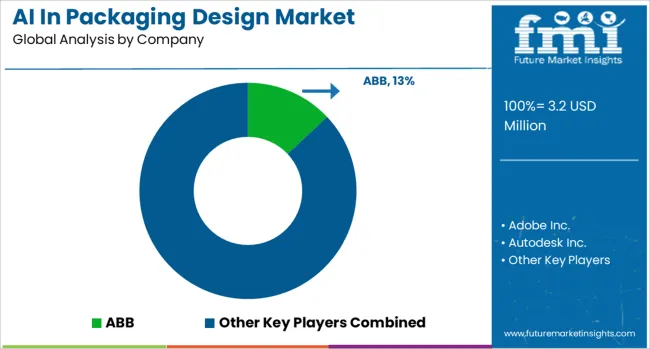
The AI in packaging design market is characterized by competition among technology giants, specialized software providers, packaging equipment manufacturers, and design agencies. Companies are investing in algorithm development, cloud infrastructure, user interface design, and industry-specific solutions to deliver accessible, powerful, and integrated AI design tools. Strategic partnerships, platform ecosystems, and continuous innovation are central to maintaining competitive advantage and market leadership.
ABB, Switzerland-based, captures 13.0% global value share through its comprehensive automation and robotics solutions integrated with AI-powered design optimization. Adobe Inc., USA, leverages its creative software dominance to integrate AI capabilities into packaging design workflows. Autodesk Inc., USA, provides advanced CAD and generative design tools specifically adapted for packaging applications. AWS, USA, offers scalable cloud infrastructure and AI services that power numerous packaging design platforms.
Dassault Systèmes, France, delivers comprehensive 3D design and simulation platforms enhanced with AI capabilities for packaging optimization. Esko-Graphics BV, Belgium, specializes in packaging-specific design software with integrated AI features for artwork and structural design. Kongsberg Precision Cutting Systems, Norway, combines cutting equipment with AI-powered design tools for integrated packaging production. SAP SE, Germany, provides enterprise software with AI modules for packaging design management and workflow optimization.
Siemens AG, Germany, offers digital twin technology and AI-powered simulation for packaging design validation. Transcontinental Inc., Canada, integrates AI into its packaging services for enhanced design and production efficiency. Sourceful Ltd, UK, focuses on renewable packaging design using AI to optimize environmental performance.
| Items | Values |
|---|---|
| Quantitative Units (2025) | USD 3.2 billion |
| Technology Outlook | Generative Design AI, Computer Vision, Natural Language Processing, AI-powered Simulation and Testing |
| Industry Vertical Outlook | Food and Beverage, Healthcare and Pharmaceuticals, Consumer Electronics, Personal Care and Beauty |
| End Use Outlook | Manufacturers and Packaging Companies, E-commerce and Retail, Packaging Design Agencies |
| Regions Covered | North America, Europe, East Asia, South Asia & Pacific, Latin America, Middle East & Africa |
| Countries Covered | United States, Canada, United Kingdom, Germany, France, China, Japan, South Korea, India, Brazil, Australia, and 40+ countries |
| Key Companies Profiled | ABB, Adobe Inc., Autodesk Inc., AWS, Dassault Systèmes, Esko-Graphics BV., Kongsberg Precision Cutting Systems, SAP SE, Siemens AG, Transcontinental Inc., and Sourceful Ltd |
| Additional Attributes | Implementation costs by company size, AI algorithm types and applications, integration capabilities with existing design software, ROI metrics and productivity improvements, data security and IP protection measures, training requirements and skill development needs, cloud versus on-premise deployment options |
The global AI in packaging design market is estimated to be valued at USD 3.2 million in 2025.
The market size for the AI in packaging design market is projected to reach USD 10.0 million by 2035.
The AI in packaging design market is expected to grow at a 12.2% CAGR between 2025 and 2035.
The key product types in AI in packaging design market are generative design ai, computer vision, natural language processing and ai-powered simulation and testing.
In terms of industry vertical outlook, food and beverage segment to command 37.9% share in the AI in packaging design market in 2025.






Our Research Products

The "Full Research Suite" delivers actionable market intel, deep dives on markets or technologies, so clients act faster, cut risk, and unlock growth.

The Leaderboard benchmarks and ranks top vendors, classifying them as Established Leaders, Leading Challengers, or Disruptors & Challengers.

Locates where complements amplify value and substitutes erode it, forecasting net impact by horizon

We deliver granular, decision-grade intel: market sizing, 5-year forecasts, pricing, adoption, usage, revenue, and operational KPIs—plus competitor tracking, regulation, and value chains—across 60 countries broadly.

Spot the shifts before they hit your P&L. We track inflection points, adoption curves, pricing moves, and ecosystem plays to show where demand is heading, why it is changing, and what to do next across high-growth markets and disruptive tech

Real-time reads of user behavior. We track shifting priorities, perceptions of today’s and next-gen services, and provider experience, then pace how fast tech moves from trial to adoption, blending buyer, consumer, and channel inputs with social signals (#WhySwitch, #UX).

Partner with our analyst team to build a custom report designed around your business priorities. From analysing market trends to assessing competitors or crafting bespoke datasets, we tailor insights to your needs.
Supplier Intelligence
Discovery & Profiling
Capacity & Footprint
Performance & Risk
Compliance & Governance
Commercial Readiness
Who Supplies Whom
Scorecards & Shortlists
Playbooks & Docs
Category Intelligence
Definition & Scope
Demand & Use Cases
Cost Drivers
Market Structure
Supply Chain Map
Trade & Policy
Operating Norms
Deliverables
Buyer Intelligence
Account Basics
Spend & Scope
Procurement Model
Vendor Requirements
Terms & Policies
Entry Strategy
Pain Points & Triggers
Outputs
Pricing Analysis
Benchmarks
Trends
Should-Cost
Indexation
Landed Cost
Commercial Terms
Deliverables
Brand Analysis
Positioning & Value Prop
Share & Presence
Customer Evidence
Go-to-Market
Digital & Reputation
Compliance & Trust
KPIs & Gaps
Outputs
Full Research Suite comprises of:
Market outlook & trends analysis
Interviews & case studies
Strategic recommendations
Vendor profiles & capabilities analysis
5-year forecasts
8 regions and 60+ country-level data splits
Market segment data splits
12 months of continuous data updates
DELIVERED AS:
PDF EXCEL ONLINE
AI Code Assistant Market Size and Share Forecast Outlook 2025 to 2035
AI-Based Data Observability Software Market Size and Share Forecast Outlook 2025 to 2035
Air Struts Market Size and Share Forecast Outlook 2025 to 2035
AI-powered Wealth Management Solution Market Size and Share Forecast Outlook 2025 to 2035
AI Document Generator Market Size and Share Forecast Outlook 2025 to 2035
Air Caster Skids System Market Size and Share Forecast Outlook 2025 to 2035
AI Platform Market Size and Share Forecast Outlook 2025 to 2035
AI-Powered Sleep Technologies Market Size and Share Forecast Outlook 2025 to 2035
AI-Powered Gait & Mobility Analytics Market Size and Share Forecast Outlook 2025 to 2035
AI-Powered Behavioral Therapy Market Size and Share Forecast Outlook 2025 to 2035
AI-Enabled Behavioral Therapy Market Size and Share Forecast Outlook 2025 to 2035
Airflow Balancer Market Size and Share Forecast Outlook 2025 to 2035
AIOps Platform Market Forecast and Outlook 2025 to 2035
Aircraft Flight Control System Market Size and Share Forecast Outlook 2025 to 2035
Airborne Radar Market Size and Share Forecast Outlook 2025 to 2035
AI-Powered CRM Platform Market Forecast Outlook 2025 to 2035
AI Animation Tool Market Forecast Outlook 2025 to 2035
Aircraft Electric Motor Market Forecast Outlook 2025 to 2035
Airport Ground Transportation Market Forecast and Outlook 2025 to 2035
AI Image Editor Market Forecast and Outlook 2025 to 2035

Thank you!
You will receive an email from our Business Development Manager. Please be sure to check your SPAM/JUNK folder too.
Chat With
MaRIA